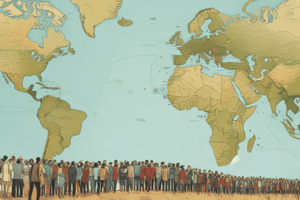Podcast
Questions and Answers
What major cardiovascular risk factor is often overlooked in clinical practice?
What major cardiovascular risk factor is often overlooked in clinical practice?
- High cholesterol
- Obesity
- Pollution (correct)
- Diabetes
Which group of patients is considered particularly susceptible to pollution-related cardiovascular disease?
Which group of patients is considered particularly susceptible to pollution-related cardiovascular disease?
- Athletes
- Healthy adults
- Children with allergies
- Patients with asthma (correct)
What action should health professionals take regarding climate change?
What action should health professionals take regarding climate change?
- Ignore the health threats
- Focus solely on infectious diseases
- Promote sustainable healthcare (correct)
- Advocate for fossil fuels
What percentage of global greenhouse gas emissions is the healthcare system responsible for?
What percentage of global greenhouse gas emissions is the healthcare system responsible for?
Which of the following is NOT listed as a susceptible patient group?
Which of the following is NOT listed as a susceptible patient group?
What is demography primarily concerned with?
What is demography primarily concerned with?
Which of the following is NOT a factor that influences population change?
Which of the following is NOT a factor that influences population change?
What main global issue is highlighted regarding health care?
What main global issue is highlighted regarding health care?
Which demographic factor is essential for health service planning?
Which demographic factor is essential for health service planning?
What has been the trend in global fertility rates over the past 50 years?
What has been the trend in global fertility rates over the past 50 years?
What is one role of medical professionals in relation to climate change?
What is one role of medical professionals in relation to climate change?
What contributes to the decline of a population?
What contributes to the decline of a population?
Which statement best describes the concept of migration?
Which statement best describes the concept of migration?
What does the Total Period Fertility Rate (TPFR) measure?
What does the Total Period Fertility Rate (TPFR) measure?
What was the estimated number of refugees and asylum seekers in 2016?
What was the estimated number of refugees and asylum seekers in 2016?
What impact did the Syrian war have on population displacement?
What impact did the Syrian war have on population displacement?
What percentage of the world's population currently lives in urban areas?
What percentage of the world's population currently lives in urban areas?
Which demographic primarily makes up international migrants?
Which demographic primarily makes up international migrants?
What was the estimated increase in displacement caused by the Taliban take-over of Afghanistan in 2021?
What was the estimated increase in displacement caused by the Taliban take-over of Afghanistan in 2021?
What is one negative public health impact of urbanization?
What is one negative public health impact of urbanization?
How many international migrants were there worldwide as stated in the content?
How many international migrants were there worldwide as stated in the content?
What initiative has the Ministry of Health in Bahrain provided for elderly care since 2008?
What initiative has the Ministry of Health in Bahrain provided for elderly care since 2008?
Which of the following is NOT one of the ten major global health threats predicted in 2019?
Which of the following is NOT one of the ten major global health threats predicted in 2019?
What is a health effect related to climate change?
What is a health effect related to climate change?
Which health threat is associated with fragile and vulnerable settings?
Which health threat is associated with fragile and vulnerable settings?
Which of the following health problems can result from food shortages as a direct health effect?
Which of the following health problems can result from food shortages as a direct health effect?
Increased migration and displacement are health effects of which major global factor?
Increased migration and displacement are health effects of which major global factor?
Which vector-borne disease is increased due to climate change?
Which vector-borne disease is increased due to climate change?
Which of the following statements is incorrect regarding Bahrain’s MOH initiatives for the elderly?
Which of the following statements is incorrect regarding Bahrain’s MOH initiatives for the elderly?
What is one of the main health risks associated with overcrowding in urban areas?
What is one of the main health risks associated with overcrowding in urban areas?
What trend concerning population ageing is projected by 2050?
What trend concerning population ageing is projected by 2050?
How is the age dependency ratio calculated?
How is the age dependency ratio calculated?
Which age group has the highest dependency ratio concerning health services?
Which age group has the highest dependency ratio concerning health services?
What is a consequence of unplanned urban housing?
What is a consequence of unplanned urban housing?
What is expected to happen to dependency ratios in the coming years?
What is expected to happen to dependency ratios in the coming years?
What condition is NOT typically associated with overcrowding?
What condition is NOT typically associated with overcrowding?
Which of the following cities is mentioned in relation to health risks from overcrowding?
Which of the following cities is mentioned in relation to health risks from overcrowding?
Flashcards are hidden until you start studying
Study Notes
Demography
- Demography is the study of human populations, focusing on size, composition, distribution, and changes over time.
- Populations are dynamic, influenced by fertility, mortality, and migration.
- Fertility is the number of births in a population. The Total Fertility Rate (TFR) represents the average number of children a woman would have over her lifetime, based on current age-specific fertility rates.
- Mortality is the number of deaths in a population.
- Migration is the movement of people into or out of a specific geographic area. It can significantly impact population growth.
- International Migration: Approximately 258 million people globally are international migrants. Most migrants are from developing countries migrating to industrialized ones.
- Refugees and Asylum Seekers: In 2016, the world had an estimated 25.9 million refugees and asylum seekers.
- War and Migration: The Syrian war has caused the largest population displacement in recent times, affecting over 6.7 million people. The Taliban takeover in Afghanistan in 2021 increased displacement by 50%. Russia's invasion of Ukraine led to the displacement of 6 million Ukrainians.
- Urbanization: Over 55% of the global population currently lives in urban areas, with this proportion expected to reach 68% by 2050.
- Negative Impacts of Urbanization: Overcrowding, slum formation, lack of sanitation, inadequate housing and infrastructure, air pollution, traffic injuries, and higher mental health issues are common in urban areas.
- Health Risks in Urban Areas: These risks are unequally distributed based on social groups.
- Population Ageing: The global population is ageing at an unprecedented pace. By 2050, the proportion of people over 60 years old will double from 12% to 22%.
- Increasing Elderly Population: The number of very elderly individuals (85+) is a key factor to consider within an ageing population.
- Dependency Ratio: This ratio represents the proportion of dependents (under 15 or over 64) to the working-age population (15-64). It's a key consideration for health planners.
- Types of Dependency Ratios:
- Young: Represents the ratio of those under 15 to the working-age population.
- Old: Represents the ratio of those over 64 to the working-age population.
- Increase in Dependency Ratios: The dependency ratio is projected to increase in the coming years.
Global Health Challenges
- Ten Major Global Health Threats (2019):
- Air Pollution & Climate Change
- Non-Communicable Diseases
- Global Influenza Pandemic
- Fragile & Vulnerable Settings
- Antimicrobial Resistance
- Ebola & Other High-Threat Pathogens
- Weak Primary Care
- Vaccine Hesitancy
- Dengue
- HIV
- Climate Change and Health:
- Pathways of Climate Change Impact: Extreme weather, altered disease patterns, famine, water crises.
- Direct Health Effects:
- Increased burden of non-communicable diseases, heat stress, vector-borne diseases, water-borne diseases, food shortage, changes in infectious disease patterns, drowning, trauma from disasters, mental health issues, violent & antisocial behavior, and mortality.
Addressing Pollution-Related Cardiovascular Disease
- Recognition of pollution as a risk factor for cardiovascular disease is crucial.
- Incorporating pollution assessment into clinical practice provides opportunities for prevention and control.
- Strategy for Reducing Air Pollution Exposure and Pollution-Related CVD:
- Patient-centered approach.
- Assessment of pollution exposure based on patient's zip code.
- Identification of susceptible patients (those with atherosclerotic CVD and coexisting conditions, recent hospitalization for acute coronary syndrome, heart failure, COPD, asthma, diabetes, stage 3/4 chronic kidney disease).
- Identifying other at-risk individuals (pregnant women, elderly, transplant recipients).
Role of Healthcare Professionals in Climate Change
- Health professionals are key in addressing the health threat of climate change.
- Promoting Sustainable Healthcare: Healthcare systems are responsible for approximately 4-5% of global greenhouse gas emissions.
- Health professionals can actively promote sustainable practices within the healthcare system.
Studying That Suits You
Use AI to generate personalized quizzes and flashcards to suit your learning preferences.




